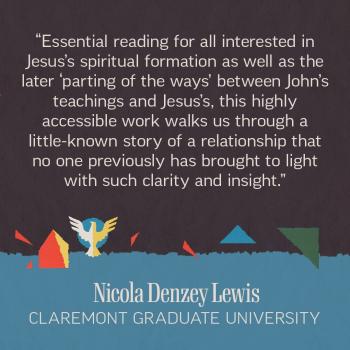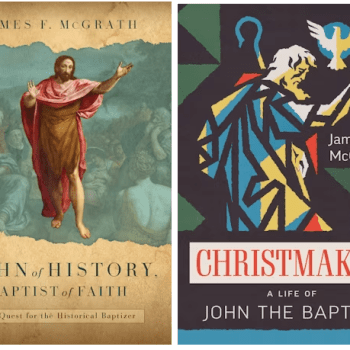I have been overdue for some time to blog about the Logos Jesus Studies Collection, a set of books which converge on the figure of Jesus from different angles. The volumes are important ones, their contents fascinating and useful to scholar and interested general reader alike. This is truly a wonderful set of resources.
Richard Burridge’s book Four Gospels, One Jesus? explores some of the topics that Burridge is best known for writing about, in a manner that is accessible to a general audience. Despite the promise of a “symbolic” reading in the book’s subtitle, the book actually gives all the major details one might hope for in an introduction to the scholarly study of the Gospels, such as form, redaction, and literary criticism, and the Synoptic problem. The question of the Gospels’ genre is given significant focus, and illustrations from teaching and the spotting of cheating or plagiarism help turn what can often seem like arcane scholarly concerns into something clear and interesting for any reader.
Symbolism comes to the fore after the introductory matters are covered, as Burridge uses the traditional animal used to symbolize each Gospel and its author, as a way of drawing together major themes. John’s eagle leads to mentions of the lunar lander and the Lord of the Rings! Burridge concludes by relating the Gospels to the historical Jesus and to contemporary Christology.
References to the New Testament in this and other books are interactive, and bring up the relevant passage in Greek, with the option of going to the fuller text. This is but one of many advantages of reading a book like this through the Logos platform rather than in traditional print form.
Jesus, The Final Days by Craig Evans and N. T. Wright is based on lectures these two scholars gave. Not aimed primarily at NT scholars, the volume is nonetheless full of a wealth of detail and interaction with primary as well as secondary sources, including Targums, Rabbinic texts, Josephus, the Dead Sea Scrolls, and the Psalms of Solomon, to name a few. Greco-Roman sources and archaeological evidence are also treated. An interesting suggestion is made regarding the popularity of ossuaries in the time of Jesus. An excellent explanation is offered of the importance of burial in Judaism, and why Jesus is likely to have been buried.
Norman Perrin’s Jesus the Temple is a study of New Testament sources, but one that is driven by a contemporary faith concern. The focus of the book is summarized on p.12: “In this book, I wish to argue that Jesus of Nazareth saw himself and his movement as nothing less than the decisive embodiment of Yahweh’s eschatological temple.” As Perrin explains in the introduction, he focuses on the possibility that Jesus thought of himself as taking the place of the temple, because this provides a potential opportunity for Jesus to transcend and encompass history. This seems to me to be a problematic starting point for historical investigation. Nonetheless, our starting points and presuppositions as scholars and readers are never out of the picture, and so this open statement of Perrin’s aim is to be appreciated. The volume begins with Jewish works and movements which were critical of the temple – the Psalms of Solomon, Dead Sea Scrolls, and John the Baptist and his followers, in particular. The image of the church as “counter-temple” is explored, as is Jesus’ temple action. Perrin makes a plausible case for the authenticity of material he discusses, such as on p.106 where he writes:
Had this phrase been the by-product of some clever early believers putting words into Jesus’ mouth, one wonders why they were not also clever enough to have Jesus predict the time of his own arrival more accurately. Exhibiting anything but ecclesial theologizing, the tag ‘after three days’ probably pre-dates Paul, certainly pre-dates Mark, and by all means shows the stamp of the most primitive tradition.
Perrin makes a number of interesting connections, including between the notion of having a “treasure room in heaven” and the temple treasury. The study makes connections between specific imagery in Jesus’ parables, the practice of exorcism, meals, and his ethic of nonviolence. Perrin explicitly states that the proposal is offered provisionally. It certainly offers a means of connecting Jesus centrally to NT theology. I fully expect Perrin’s proposal to stimulate scholarly discussion in lots of interesting and exciting ways.
In Jesus and the Land, Gary Burge offers a survey of the theme of land and territory in the New Testament. It highlights both what the texts do say, and what they do not say – the latter often represents a marked contrast to what one would expect if the authors of these texts had embraced traditional Jewish territorial emphases and expectations. Burge concludes with an evaluation of today’s so-called “Christian Zionism” in light of the New Testament. This volume needs to be widely read by those who use the New Testament to justify their stance regarding the modern state of Israel and the Palestinians, as there are views which are held as though they are “what the Bible says,” but which are in fact diametrically opposed to the teachings and emphases of the early Christian writings.
Margaret Barker’s book Christmas, the Original Story is interesting not only because of Barker’s very distinctive interpretation of early Christology, but also because she reads the New Testament infancy stories in conversation with Islam. And so the book is of interest not only for those engaged in the study of the Gospels, but also for those engaged in contemporary inter-religious dialogue.
In the book, the Temple structure and its symbolism is given much attention. Barker ultimately sees the New Testament and other depictions of Jesus as rooted in ancient Israelite traditions about the king and about a second divine figure, as Barker has explored in past books. Here is an example:
The words of Gabriel are the key to the original story of the birth of Jesus. What did it mean to be ‘Son of the Highest’, that is, to be Yahweh the Lord? The context is the royal rituals of the old temple, when the new king was enthroned and became the human presence of the Lord. Since the first Christians knew that the Lord was the Son of God Most High, and that God Most High had allotted Jacob to him as his special people, this is how we should understand Gabriel’s message. The child, like the ancient kings, would be given the Name (Yahweh the Lord), and established as his presence and his king on earth. The two stages of sonship, the two births, are assumed here, not explained: the relationship within the divine—the Most High and the Son, the eternal generation of the Son; and then the relationship of the divine and the human—the Son and his earthly manifestation, the Virgin birth and the incarnation.
While those who find Barker’s particular Christological views unpersuasive are unlikely to have their minds changed by this volume, her attention to detail, interaction with other ancient sources such as the Qumran texts, and exploration of matters of contemporary relevant that are not often treated in Biblical scholarship makes this volume an important and interesting one nonetheless.
Finally, Steve Moyise’s Jesus and Scripture looks at how Jesus interpreted and used Scripture, a subject that is all too often neglected – in particular by those who self-identify as followers of Jesus and who consider Scripture important! That Jesus often gave one text priority over another, or used one text to essentially overrule and nullify another (as in the case of his prohibition of divorce), is brought to the fore. Jesus’ use of Scripture is compared to that of other ancient Jews. Text boxes address aspects of New Testament scholarship that can normally be taken for granted by scholars but may not be familiar to a general audience – such as the question of the Q source, or the criteria used in evaluating the historicity of material in the Gospels. After chapters examining the Gospels, a survey of scholars’ views is offered, categorized as “minimalist,” “moderate,” and “maximalist” in terms of how much material they deem historical, and with what degree of confidence. Moyise helpfully highlights that the differences between these stances are not just about religious commitments (although that is part of the picture in many cases) but also about historical judgments. A useful appendix lists all the instances of Jesus purportedly citing Scripture, and as was mentioned previously, each reference can be clicked to bring up a pop-up box with the New Testament text in Greek or the Hebrew Bible in English.
Each of these volumes is an important contribution to some aspect of the study of Jesus, and taken together, they represent an important cross-section of recent New Testament scholarship. The matter of the historical Jesus is perhaps given the most attention, but contemporary Christology, literary considerations, ancient Judaism, and inter-religious dialogue are brought into conversation with the standard elements of academic study. Most of the volumes provide an introduction to an important aspect of the academic study of Jesus, as well as the author’s distinctive perspective and insights. The ability to conveniently carry the books with me, and cross-reference the Biblical texts at the tap of a finger, is an added plus. I highly recommend the Logos Jesus Studies Collection to any and all who are interested in Jesus and/or the New Testament, and I am very grateful to Logos for having provided me with a review copy so that I could dive into these important scholarly volumes!
NOTE: When I first published this, I mentioned that I had occasionally experienced issues with accessing the resources when I was without a wi-fi connection. While I have sometimes found this to be true even with the SBL Greek New Testament, which I know I have downloaded to my device, the other books I seem to have neglected to download and so it was presumably my own error on this occasion. When taking your iPad with you on a long train or plane journey to be able to read, don’t forget to download the books to your device so that you can access them even without the internet!













